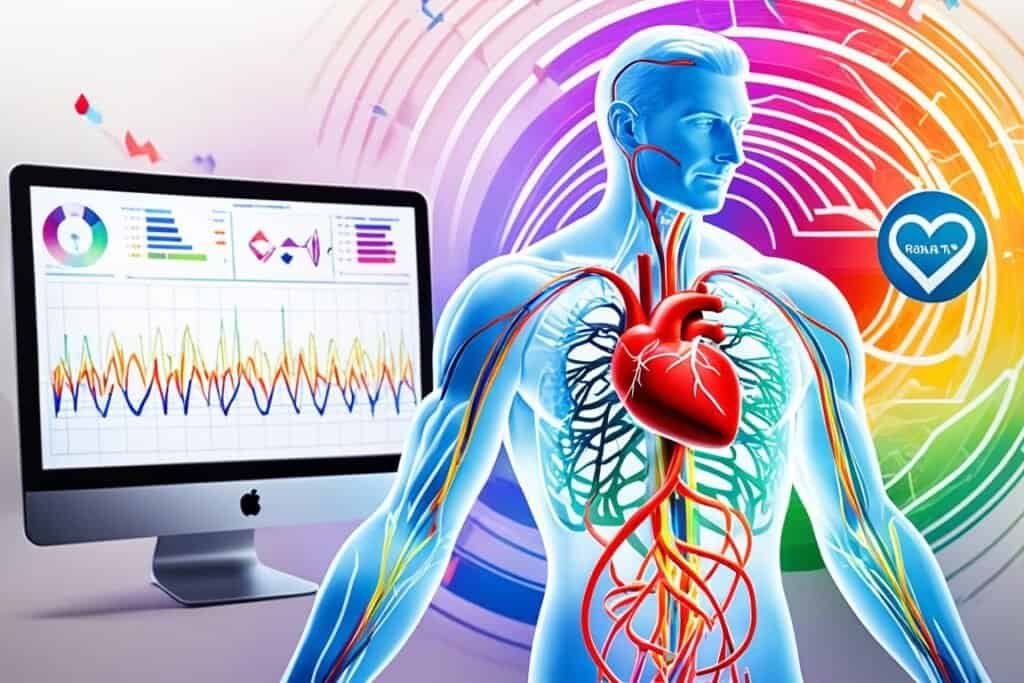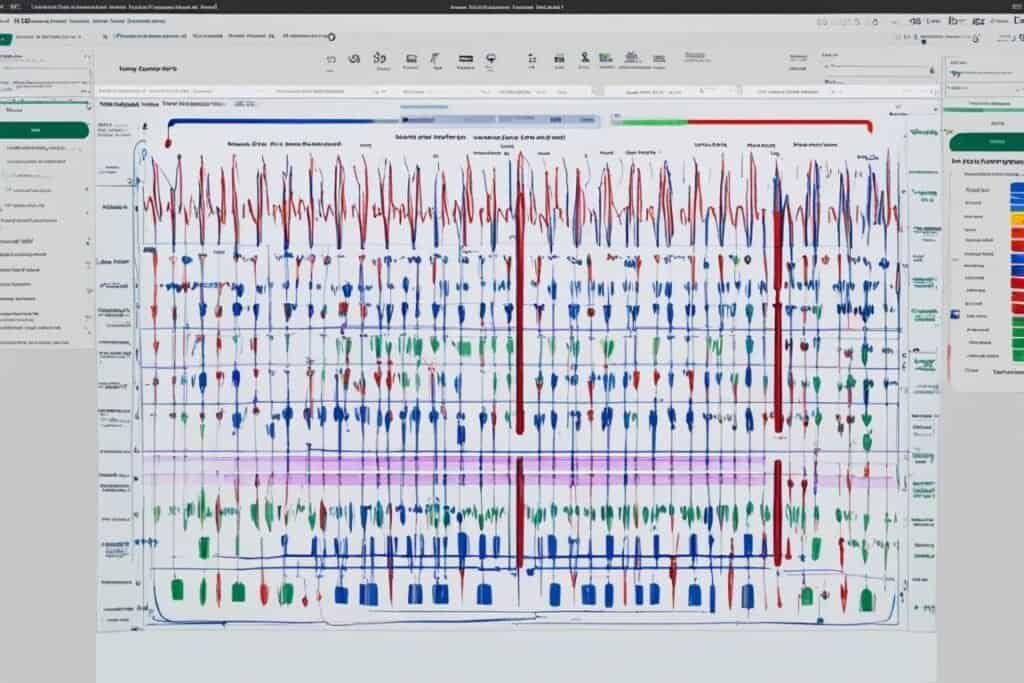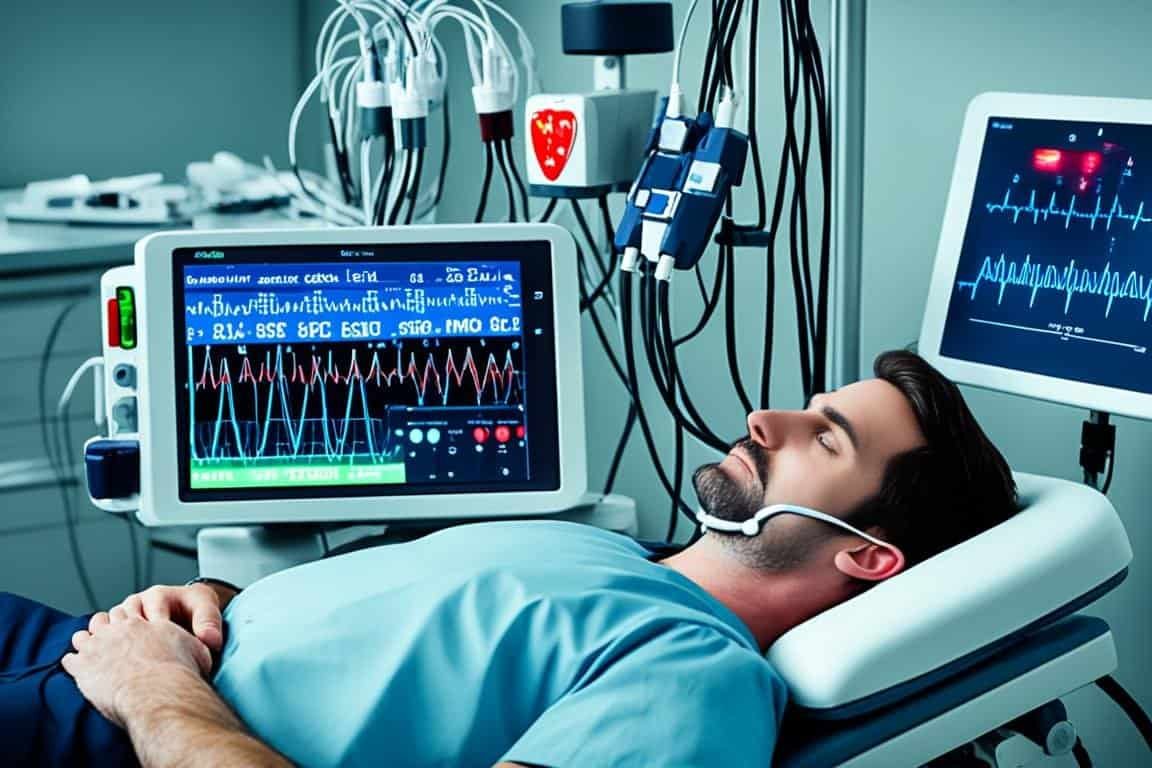Welcome to our comprehensive guide on different types of ECG tests, specifically focusing on 12-lead EKGs and Holter monitors. These tests play a vital role in cardiac monitoring and electrocardiogram interpretation, providing valuable insights into heart rhythm analysis and overall heart health.
Electrocardiograms, commonly known as EKG or ECG tests, are essential tools in diagnosing and monitoring heart conditions. They help healthcare providers understand the electrical activity of the heart, detect abnormalities, and develop tailored treatment plans. In this article, we will delve into the specifics of 12-lead EKGs and Holter monitors, exploring their uses, advantages, and importance in cardiac health analysis.
Whether you’re a healthcare professional or an individual looking to gain a better understanding of your heart health, this article will provide you with valuable insights into the different types of ECG tests and their significance in EKG interpretation. So let’s dive in!
Key Takeaways:
- 12-lead EKGs and Holter monitors are two different types of ECG tests used for heart health analysis.
- 12-lead EKG captures a snapshot of the heart’s electrical activity at a specific point in time, while Holter monitors provide continuous monitoring of the heart’s activity for an extended period.
- Both tests are important in diagnosing and monitoring heart conditions, offering valuable insights for ECG interpretation.
- Holter monitors are portable devices used to detect irregular heart rhythms and assess the risk and severity of heart disease.
- 12-lead EKGs offer a comprehensive view of the heart’s electrical system, aiding in the diagnosis of heart abnormalities and developing tailored treatment plans.
Understanding Holter Monitors
A Holter monitor is a wearable device that records the heart’s rhythm for an extended period of time, usually 24 to 48 hours. It is used to detect or determine the risk of irregular heartbeats, known as arrhythmias. Holter monitors are particularly helpful in capturing infrequent arrhythmias that may not be detected by a standard electrocardiogram (ECG) test. They are often recommended for individuals experiencing symptoms such as unexplained fainting or signs of an irregular heart rhythm.
During the monitoring period, the Holter monitor continuously records the electrical signals produced by the heart. These signals are then analyzed through heart rhythm analysis software, providing healthcare providers with valuable insights into the patient’s heart health.
One of the key advantages of using a Holter monitor is its ability to capture irregular heartbeats during daily activities. Unlike a standard ECG test that only captures a snapshot of the heart’s rhythm at a specific moment, a Holter monitor provides a comprehensive overview of the heart’s activity over an extended period.
The data collected from the Holter monitor helps healthcare providers in diagnosing and monitoring various cardiac conditions, including arrhythmias, heart rate variability, and other irregularities. It provides them with a detailed understanding of the heart’s functioning, allowing for accurate diagnosis and appropriate treatment plans.
In the next section, we will explore the different uses of Holter monitors in diagnosing heart conditions and assessing the effectiveness of treatments.
Uses of Holter Monitors
Holter monitors are versatile devices with a range of uses, making them an essential tool in diagnosing and monitoring heart conditions. These portable monitors are particularly valuable in detecting irregular heart rhythms, assessing the effectiveness of medications in controlling heart issues, and evaluating the risk and severity of heart disease.
If you experience symptoms of an irregular heart rhythm, such as palpitations or a fluttering sensation in your chest, your doctor may recommend a Holter monitor. The monitor records your heart’s activity continuously for an extended period, typically 24 to 48 hours, allowing healthcare providers to capture and analyze any irregularities.
Individuals with unexplained fainting episodes may also benefit from using a Holter monitor. The monitor can help identify whether the fainting is caused by an underlying heart condition, such as arrhythmias, allowing for proper diagnosis and appropriate treatment.
Patients with known heart conditions that increase the risk of arrhythmias, such as coronary artery disease or heart failure, may be advised to use a Holter monitor regularly. This long-term monitoring provides valuable data that helps healthcare providers assess the effectiveness of medications, make necessary adjustments to treatment plans, and monitor the progression of the condition.
In summary, Holter monitors play a crucial role in diagnosing and managing heart conditions by detecting irregular heart rhythms, evaluating medication efficacy, and assessing the risk and severity of heart disease.
Uses of Holter Monitors
| Uses | Description |
|---|---|
| Detecting irregular heart rhythms | Continuous monitoring allows for the identification and analysis of irregular heartbeats. |
| Assessing medication effectiveness | Monitoring the heart’s response to medication helps healthcare providers determine the best course of treatment. |
| Evaluating risk and severity of heart disease | Long-term monitoring provides insights into the risk factors and progression of heart conditions. |
The image above depicts a Holter monitor, a portable device used for the continuous monitoring of heart activity.
Different Types of Holter Monitors
When it comes to monitoring your heart’s activity, there are several types of Holter monitors available. Each type serves a unique purpose based on the duration and method of monitoring. Let’s explore the different types of Holter monitors:
Traditional Holter Monitor
The Traditional Holter monitor is a portable device that records your heart’s activity for 24 to 48 hours. During this time, the monitor continuously captures data, providing valuable insights into your heart rhythm and detecting any irregularities. This type of monitor is typically recommended for individuals experiencing symptoms like palpitations or unexplained fainting.
Extended-Wear Holter Monitor
If your healthcare provider needs a longer period of monitoring, they may suggest an extended-wear Holter monitor. With an extended-wear monitor, you can wear it for up to two weeks while going about your daily activities. This option allows for a more comprehensive analysis of your heart’s activity, providing a clearer picture of any potential issues that may arise.
Event Monitor
An event monitor is another type of Holter monitor that is used on an intermittent basis. It is activated by the individual when they experience symptoms like chest pain, dizziness, or shortness of breath. The monitor will then record the heart’s activity during the event, providing critical data for further analysis. Event monitors are particularly useful when symptoms are infrequent or sporadic.
Mobile Cardiac Telemetry
Mobile cardiac telemetry, also known as MCT, combines the benefits of both traditional Holter monitors and event monitors. It offers continuous monitoring of your heart’s activity with real-time data transmission. MCT devices are designed to be worn for an extended period, allowing for comprehensive monitoring of your heart’s rhythm and providing accurate insights for diagnosis and treatment.
These different types of Holter monitors serve distinct purposes based on the duration and method of monitoring. Your healthcare provider will recommend the most suitable option for your specific needs. Now that you have a better understanding of the various types, you can have an informed discussion with your healthcare provider about which Holter monitor is right for you.
| Type of Holter Monitor | Duration of Monitoring | Monitoring Method |
|---|---|---|
| Traditional Holter Monitor | 24 to 48 hours | Continuous recording |
| Extended-Wear Holter Monitor | Up to two weeks | Continuous recording |
| Event Monitor | Intermittent, activated during symptoms | Event-triggered recording |
| Mobile Cardiac Telemetry | Extended period | Continuous recording with real-time data transmission |
Benefits of Holter Monitors
Holter monitors offer numerous benefits in the field of cardiology. These non-invasive devices provide a comprehensive and detailed overview of your heart’s activity throughout a typical day, allowing healthcare providers to gather crucial information about your heart health.
One key advantage of Holter monitors is their ability to detect intermittent arrhythmias that may go unnoticed during shorter tests. Arrhythmias are irregular heart rhythms that can be a sign of underlying heart conditions. By capturing these intermittent arrhythmias, Holter monitors enable early detection and intervention, leading to better patient outcomes.
Moreover, Holter monitors enhance patient compliance due to their comfort and discreet nature. Unlike other cardiac monitoring devices, Holter monitors are designed to be worn comfortably for an extended period, ensuring accurate and uninterrupted heart activity monitoring. This continuous and accurate data contributes to a more accurate diagnosis, enabling healthcare providers to develop appropriate treatment plans.

To summarize, Holter monitors play a crucial role in maintaining optimal heart health. With their non-invasive nature, ability to detect arrhythmias, and patient-friendly design, Holter monitors provide valuable insights that can lead to early intervention and improved patient outcomes.
Introduction to 12-Lead ECGs
A 12-lead ECG is a diagnostic test that measures the electrical activity of the heart from 12 different angles or perspectives. It provides a comprehensive view of the heart’s electrical system, allowing healthcare providers to analyze the heart’s rhythm, detect abnormalities, and assess overall cardiac health. 12-lead ECGs are commonly used in hospitals and healthcare facilities for initial heart assessments and ECG interpretations.
During a 12-lead ECG, electrodes are placed on specific areas of the body to capture the electrical signals produced by the heart. These signals are then recorded and displayed on a graph, enabling healthcare providers to evaluate the different components of cardiac activity, such as the rate and regularity of heartbeats, the presence of any conduction abnormalities, and signs of ischemia or heart muscle damage.
With the information gathered from a 12-lead ECG, healthcare providers can assess various aspects of heart health, including the presence of arrhythmias, indications of heart attack, and signs of heart disease. This diagnostic test is valuable in identifying conditions such as atrial fibrillation, ventricular hypertrophy, and myocardial infarction, allowing for timely interventions and appropriate treatment plans.
When interpreting the results of a 12-lead ECG, healthcare providers consider several factors, including the shape, duration, and timing of the different waves and intervals on the graph. Abnormalities in these patterns can indicate potential cardiac problems, requiring further investigation or referral to a specialist for a more detailed assessment.
In addition to its diagnostic role, a 12-lead ECG can also serve as a baseline assessment for individuals with known heart conditions. By comparing subsequent ECGs to the initial recording, healthcare providers can track changes in cardiac function over time and adjust treatment plans accordingly.
Overall, the 12-lead ECG is a fundamental tool in cardiology, providing crucial insights into heart health and aiding in the interpretation of cardiac activity. Its wide availability and established diagnostic value make it an essential component of comprehensive cardiovascular assessments.
Advantages of 12-Lead ECGs
When it comes to cardiac health analysis, 12-lead ECGs offer several key advantages. These tests have the ability to capture heart abnormalities that may be difficult to detect during a standard ECG test. By providing a comprehensive view of the heart’s electrical activity from 12 different angles, 12-lead ECGs can uncover valuable insights into cardiac health.
One of the significant benefits of 12-lead ECGs is their effectiveness in diagnosing conditions like atrial fibrillation (Afib), a common heart rhythm disorder. With their ability to detect subtle irregularities in the heart’s electrical signals, 12-lead ECGs can help healthcare providers accurately identify and assess Afib, enabling timely treatment and management.
Furthermore, 12-lead ECGs play a vital role in ECG interpretation. The detailed information obtained from these tests can provide essential data for healthcare providers to determine the presence of heart abnormalities and evaluate overall cardiac health. This information guides them in developing tailored treatment plans for their patients.

| Advantages of 12-Lead ECGs | Description |
|---|---|
| Comprehensive view | Provides an extensive perspective of the heart’s electrical activity from 12 different angles |
| Early detection | Identifies heart abnormalities that may be challenging to detect using standard ECG tests |
| Diagnosing Afib | Effectively detects and diagnoses atrial fibrillation (Afib) |
| ECG interpretation | Offers valuable data for healthcare providers to interpret and assess cardiac health |
| Tailored treatment | Aids healthcare providers in developing personalized treatment plans based on individual results |
Overall, 12-lead ECGs are indispensable tools in the assessment of cardiac health. By capturing detailed information about the heart’s electrical activity and enabling early detection of abnormalities, they assist healthcare providers in providing precise diagnoses and developing effective treatment strategies.
Conclusion
Holter monitors and 12-lead ECGs are two different types of ECG tests that play a crucial role in the analysis of heart health. Holter monitors provide continuous monitoring of the heart’s rhythm over an extended period, making them valuable in detecting irregularities and capturing infrequent arrhythmias. On the other hand, 12-lead ECGs offer a comprehensive view of the heart’s electrical activity, aiding in the diagnosis and assessment of overall cardiac health.
Both types of ECG tests, the Holter monitor and the 12-lead ECG, are essential tools in diagnosing and monitoring heart conditions. They provide valuable insights for ECG interpretation, enabling healthcare providers to develop tailored treatment plans. By understanding the different types of ECG tests available, both individuals and healthcare professionals can make informed decisions regarding heart health monitoring and treatment.
Regular cardiac monitoring through different types of ECG tests is vital for maintaining heart health. Whether it’s the continuous monitoring offered by Holter monitors or the comprehensive analysis provided by 12-lead ECGs, these tests contribute significantly to early detection, intervention, and management of heart conditions. Prioritizing regular ECG testing can help individuals prevent potential complications and ensure proactive heart care for a healthier future.

